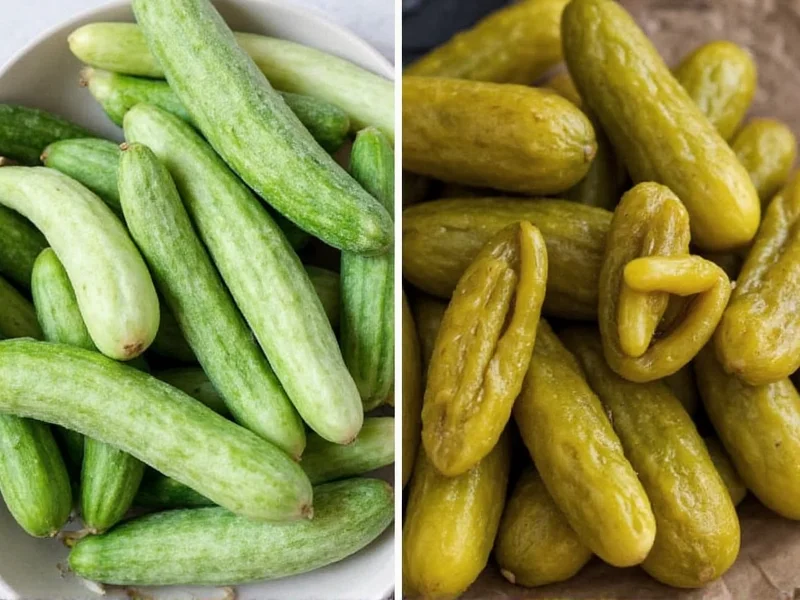Understanding the distinction between cucumbers and pickles goes beyond simple semantics—it involves food science, nutrition, and culinary tradition. Many people wonder are pickles just pickled cucumbers, and the straightforward answer is yes, but with important nuances that affect flavor, texture, and nutritional value.
The Fundamental Relationship
Cucumbers (Cucumis sativus) are fresh vegetables harvested at various stages of maturity. Pickles are the product of preserving cucumbers through a process called pickling. This transformation creates significant differences in several key areas:
- Botanical identity: Cucumbers are the raw ingredient; pickles are the preserved product
- Processing: Pickling involves submerging cucumbers in brine, vinegar, or through fermentation
- Chemical composition: The pickling process alters pH levels and creates new compounds
- Shelf life: Fresh cucumbers last 1-2 weeks refrigerated; properly canned pickles can last 1-2 years
Cucumber Varieties Specifically Grown for Pickling
Not all cucumbers make good pickles. Farmers cultivate specific varieties with characteristics ideal for preservation:
- Pickling cucumbers: Shorter, thicker-skinned, and typically 3-5 inches long
- Kirby cucumbers: The most common commercial pickling variety with bumpy skin
- Gherkin cucumbers: Very small (1-2 inches), often used for cornichons
- Regular slicing cucumbers: Higher water content makes them less ideal for pickling
| Characteristic | Pickling Cucumbers | Slicing Cucumbers |
|---|---|---|
| Average Length | 3-6 inches | 8-14 inches |
| Skin Thickness | Thicker, tougher | Thinner, more delicate |
| Seeds | Smaller, less developed | Larger, more mature |
| Water Content | Lower (85-88%) | Higher (95-96%) |
| Best Used For | Pickling, relishes | Fresh salads, sandwiches |
The Science Behind Pickling
The how are pickles made from cucumbers process involves either:
- Vinegar-based pickling: Cucumbers submerged in vinegar solution (typically 5-6% acetic acid) with salt, spices, and sugar. This method creates quick pickles ready in days.
- Fermentation pickling: Cucumbers submerged in saltwater brine (3-5% salt solution), allowing natural bacteria to convert sugars to lactic acid over 2-6 weeks. This creates traditional fermented pickles like dill pickles.
During fermentation, Lactobacillus bacteria consume cucumber sugars and produce lactic acid, which preserves the cucumbers while creating complex flavors. The pH drops from approximately 5.5-7.0 in fresh cucumbers to 3.2-3.6 in finished pickles—this acidic environment prevents harmful bacteria growth.
Nutritional Comparison: Cucumbers vs Pickles
When examining cucumber pickle nutrition facts, significant changes occur during pickling:
- Sodium content: Fresh cucumbers contain 2mg sodium per 100g, while pickles contain 800-1,200mg due to the brine
- Vitamin C: Pickling reduces vitamin C content by approximately 25-30%
- Probiotics: Fermented pickles contain beneficial bacteria not present in fresh cucumbers
- Calories: Both remain low-calorie (15-16 calories per 100g), though some sweet pickles add sugar
The nutritional value of cucumbers vs pickles shows trade-offs: pickles gain probiotics and extended shelf life but lose some vitamins and gain sodium. For those monitoring sodium intake, low-sodium pickle varieties are increasingly available.
Flavor and Texture Transformation
The pickling process dramatically alters sensory properties. Fresh cucumbers offer mild, refreshing flavor with high water content (95%) and crisp texture. Pickles develop:
- Tangy, acidic flavor profile from vinegar or lactic acid
- Enhanced spice notes from added dill, garlic, mustard seed, etc.
- Firmer, sometimes crunchier texture (though over-pickling causes mushiness)
- Complex umami notes in fermented varieties
These changes explain why fresh cucumbers versus pickled cucumbers behave so differently in culinary applications. Cucumbers work best in fresh salads and sandwiches where their high water content provides refreshment, while pickles excel as condiments, garnishes, or ingredients where their bold flavor can cut through richness.
Common Misconceptions Clarified
Several myths persist about the difference between cucumbers and pickles:
- Misconception: "Pickles are a different vegetable than cucumbers"
Fact: Pickles are always made from cucumbers—no other vegetable is called "pickle" by itself (though we have pickled beets, onions, etc.) - Misconception: "All cucumbers can be turned into perfect pickles"
Fact: Slicing cucumbers often become mushy when pickled due to higher water content and enzymes - Misconception: "Pickles have no nutritional value"
Fact: While some nutrients decrease, fermented pickles gain probiotics and retain many minerals
Practical Applications in Cooking
Understanding these differences helps optimize their use in cooking. Chefs leverage health benefits of cucumbers compared to pickles strategically:
- Use fresh cucumbers in gazpacho, tzatziki, or cucumber salads where water content provides desirable texture
- Choose pickles for burgers, sandwiches, or charcuterie boards where their acidity balances rich flavors
- Substitute pickle brine for vinegar in dressings to add complexity
- Use fermented pickles as probiotic sources in otherwise cooked meals
When recipes call for "pickles" without specification, understanding whether vinegar-pickled or fermented varieties work best can significantly impact the final dish's flavor profile and texture.











 浙公网安备
33010002000092号
浙公网安备
33010002000092号 浙B2-20120091-4
浙B2-20120091-4